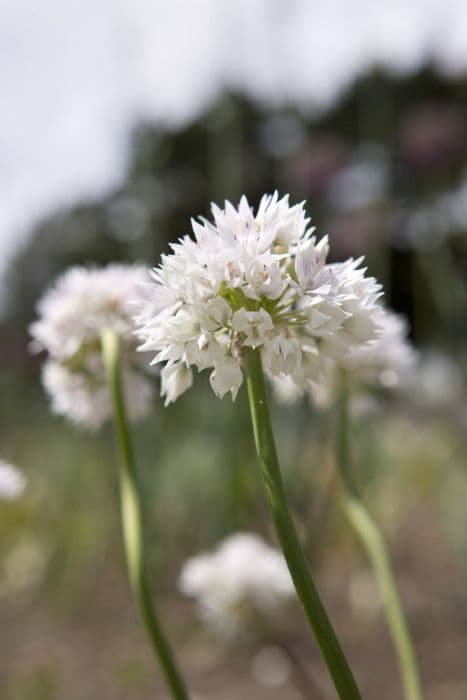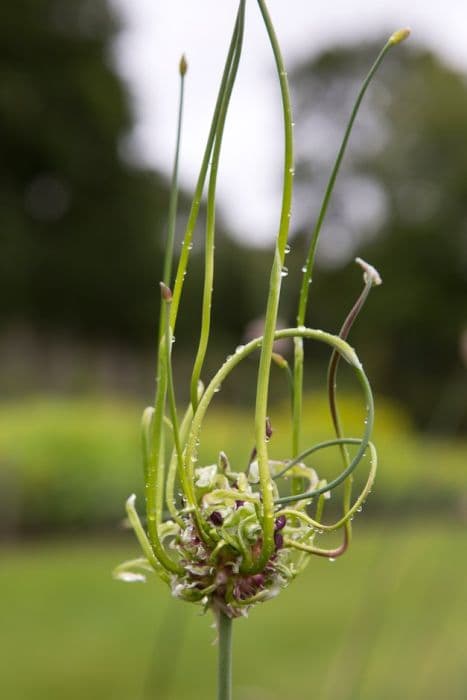Miami Allium Allium 'Miami'

ABOUT
Allium 'Miami' is a cultivar of ornamental onion that is known for its distinctive blooms and foliage. It typically features a large, rounded cluster of star-shaped flowers that come together to form a spherical bloom, resembling a radiant globe. The flowers are usually a deep, vibrant purple or violet, which creates a striking contrast against the lighter colors of surrounding plants. Beneath the blooms, the plant has slender, straight stems that are sturdy and hold the flower heads aloft. The foliage consists of long, narrow, and glossy green leaves that form a tuft at the base of the stem. These leaves have a slightly grassy appearance and can sometimes have a blue-green hue. All in all, the Allium 'Miami' has a showy and elegant presence in any garden or floral arrangement.
About this plant
 Names
NamesSynonyms
Miami Allium, Ornamental Onion
Common names
Allium 'Miami'.
 Toxicity
ToxicityTo humans
The Allium 'Miami', commonly known as an ornamental onion, is not generally considered highly toxic to humans. However, like other members of the Allium family, if consumed in large quantities, it could cause gastrointestinal discomfort. Symptoms may include nausea, vomiting, and diarrhea. Contact with the plant's sap can sometimes cause skin irritation or allergic reactions in sensitive individuals.
To pets
The Allium 'Miami', commonly known as an ornamental onion, is toxic to both cats and dogs. Members of the Allium genus contain compounds that can cause oxidative damage to red blood cells leading to hemolytic anemia. Symptoms of poisoning in pets may include vomiting, diarrhea, abdominal pain, lethargy, elevated heart and respiratory rates, weakness, and collapse. In severe cases, jaundice, red-colored urine, or difficulty breathing may occur. If a pet has ingested ornamental onions, immediate veterinary attention is required.
 Characteristics
CharacteristicsLife cycle
Perennials
Foliage type
Deciduous
Color of leaves
Green
Flower color
Pink
Height
2-3 feet (60-90 cm)
Spread
1-2 feet (30-60 cm)
Plant type
Bulb
Hardiness zones
5
Native area
Europe
Benefits
 General Benefits
General Benefits- Attracts Pollinators: 'Miami' allium draws bees, butterflies, and other beneficial insects to the garden, which helps pollinate plants.
- Low Maintenance: Once established, it requires minimal care, making it a convenient choice for busy gardeners.
- Drought Tolerant: It's capable of surviving in drier conditions once mature, saving water resources.
- Deer and Rodent Resistant: Its strong scent and taste tend to repel deer and rodents, protecting your garden.
- Long Bloom Time: 'Miami' allium offers a lengthy flowering period, providing aesthetic appeal for an extended time.
- Architectural Interest: The spherical blooms add a striking visual element to mixed borders and garden designs.
- Multiplication Over Time: It can spread through bulb division, creating a fuller display as years go by.
- Seasonal Color: It brings vibrant colors to the garden when many other plants may not be in bloom.
- Easy to Combine: Its distinct flower shape and height make it easy to combine with other perennials for a varied garden display.
 Medical Properties
Medical PropertiesThis plant is not used for medical purposes.
 Air-purifying Qualities
Air-purifying QualitiesThis plant is not specifically known for air purifying qualities.
 Other Uses
Other Uses- Photography backdrops: The Allium 'Miami', with its globe-like purple flowers, can provide a striking background for close-up nature photography or serve as a focal point in garden photography.
- Artistic inspiration: Artists may use the allium as a model for botanical drawings, paintings, or even sculptures due to its unique and geometric floral structure.
- Dye source: The petals of the Allium 'Miami' can potentially be used to create a natural dye for fabrics, offering shades of purple or blue depending on the process.
- Floral arrangements: The sturdy stems and long-lasting blooms make alliums a popular choice for inclusion in fresh or dried floral arrangements.
- Feng Shui: Some practitioners use the Allium 'Miami' in their gardens to create a sense of balance and harmony, as advised by Feng Shui principles.
- Culinary presentation: Although not a common edible variety, the allium could be used decoratively on food platters or as a garnish to add visual appeal to dishes.
- Garden structures: Dried Allium 'Miami' stems can be used in the construction of natural garden ornaments or trellises, which can blend organically into the garden scape.
- Seed crafts: Once the allium flowers have produced seeds, these can be collected and used for crafting purposes, such as making seed art or combining them in potpourri.
- Garden pathway borders: Planted in a linear fashion, they can serve as an attractive and natural border along garden pathways.
- Educational tool: Biology teachers may use the Allium 'Miami' to illustrate flower anatomy and pollination processes to students during outdoor educational sessions.
Interesting Facts
 Feng Shui
Feng ShuiThe ornamental onion is not used in Feng Shui practice.
 Zodiac Sign Compitability
Zodiac Sign CompitabilityThe ornamental onion is not used in astrology practice.
 Plant Symbolism
Plant Symbolism- Unity: Like other members of the Allium family, 'Miami' alliums have round, globe-like flowers representing unity and togetherness.
- Patience: The Allium 'Miami', similar to garlic and onions, takes time to develop and bloom, symbolizing patience and the reward of waiting.
- Strength: With their sturdy stems and resilient nature, alliums embody strength and endurance.
- Prosperity: In some cultures, allium flowers are associated with abundance and prosperity, possibly due to their full, dense heads.
- Protection: Historically, alliums like garlic have been used for protection against evil spirits, and this symbolism extends to ornamental varieties like the Allium 'Miami'.
- Humility: Despite their showy appearance, they are also symbolic of humility, arising from their common and unassuming beginnings as members of the onion family.
 Water
WaterOrnamental onions, such as Allium 'Miami', should be watered liberally during their growing season, which is generally in the spring and early summer. Preferably, give them about an inch of water each week, either through rainfall or manual watering. Once established, they are quite drought tolerant, and the watering frequency can be reduced. During dormant periods, especially in late summer to fall, watering should be very minimal. It's important to avoid overwatering as this can lead to bulb rot.
 Light
LightOrnamental onions, like Allium 'Miami', thrive in full sunlight. They perform best when they receive at least 6 to 8 hours of direct sunlight daily. The ideal location for these plants is a spot that gets unfiltered sunlight for the majority of the day. Partial shade is acceptable but may result in weaker stems and fewer blooms.
 Temperature
TemperatureOrnamental onions are hardy in a range of temperatures but they grow best when daytime temperatures are between 55°F and 75°F. They can survive temperatures as low as 20°F and can tolerate summer highs up to around 90°F. Planting them in a location where they can experience the coolness of spring and warmth of summer is ideal for their growth cycle.
 Pruning
PruningOrnamental onions, like Allium 'Miami', should be deadheaded after the blooms have faded to promote a tidy appearance and prevent self-sowing. Pruning is typically not necessary for foliage, as it naturally dies back after flowering. The best time for deadheading is late summer when flowering is complete, although seed heads can be left for visual interest if desired.
 Cleaning
CleaningAs needed
 Soil
SoilMiami Allium, also known as ornamental onion, thrives in well-draining soil with a high proportion of organic matter. A blend consisting of garden soil, compost, and perlite or sand is ideal. The pH should be slightly acidic to neutral, ranging from 6.0 to 7.0.
 Repotting
RepottingOrnamental onions like the Miami Allium should generally be repotted every 2-3 years to refresh the soil and accommodate bulb growth. Repotting is best done after the flowering period or in the fall.
 Humidity & Misting
Humidity & MistingMiami Allium, as an ornamental onion, is quite adaptable and does not require a specific humidity level, flourishing in average outdoor conditions. It tolerates a wide range of humidity as long as it is planted in well-draining soil.
 Suitable locations
Suitable locationsIndoor
Ensure bright light and good air circulation for indoor Miami Allium.
Outdoor
Plant Miami Allium in full sun and well-drained soil.
Hardiness zone
4-9 USDA
 Life cycle
Life cycleThe life cycle of the Allium 'Miami', commonly known as the ornamental onion, begins with seed germination, which occurs in late winter to early spring when soil temperatures warm up. Following germination, the plant begins to establish a root system and sprout foliage, developing long, strappy leaves. As the season progresses into late spring or early summer, Allium 'Miami' produces a sturdy stem that bears a spherical flower cluster, or umbel, consisting of numerous tiny, star-shaped flowers that can attract pollinators such as bees and butterflies. After the flowering period, the plant sets seeds, which mature by late summer and can be dispersed by wind or wildlife, completing the reproductive cycle. Throughout the growing season, the plant stores energy in an underground bulb, which allows it to survive winter dormancy and regrow the following year. If not grown from seed, propagation can also be done by dividing these bulbs every few years, typically in the fall.
 Propogation
PropogationPropogation time
Spring-Early Summer
The Allium 'Miami', commonly referred to as ornamental onion, is frequently propagated by dividing the bulbs. The ideal time for this is in late summer to early fall, after the leaves have died back. To propagate, carefully dig up the clump of bulbs and gently separate them. Choose healthy and firm bulbs for replanting. Place them at a depth approximately three times the diameter of the bulb, which generally means about 6 to 8 inches (15 to 20 centimeters) apart in well-drained soil. The bulbs should be set into the soil with their pointed ends up. This method ensures the growth of new ornamental onion plants that will bloom in the following season.








